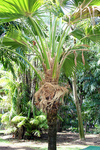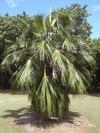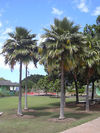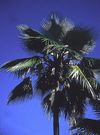Genus Pritchardia
Eupritchardia Kuntze Styloma O.Species in the genus Pritchardia of plants
Pritchardia affinis - Pritchardia affinis is a species of palm tree that is endemic to the Hawaiian Islands. Wild populations currently exist on the leeward side of the Island of Hawai?i. It was most likely cultivated by Native Hawaiians, so its exact native range is uncertain. P. affinis reaches a height of 10–25 m . It is threatened by habitat loss.
Pritchardia aylmer-robinsonii - Pritchardia aylmer-robinsonii is a species of palm tree that is endemic to the island of Ni?ihau, Hawaii, United States. It inhabits coastal dry forests at an elevation of 70–270 m . P. aylmer-robinsonii reaches a height of 7–15 m and a trunk diameter of 20–30 cm . Harold St. John discovered this species in 1949, and the specific name refers to Aylmer Francis Robinson, a member of the family that owned the island.
Pritchardia elliptica - Pritchardia lanaiensis, the L?na?i Pritchardia, is a species of fan palm that is endemic to Hawaii in the United States. It can only be found on the island of L?na?i.
Lanai pritchardia - Pritchardia lanaiensis, the L?na?i Pritchardia, is a species of fan palm that is endemic to Hawaii in the United States. It can only be found on the island of L?na?i.
Limahuli Valley pritchardia - It is a medium-sized palm, growing to 10 m tall, with palmate leaves.
Pritchardia napaliensis - Pritchardia napaliensis is a species of palm tree that is endemic to the island of Kaua?i in Hawaii, United States. It inhabits gulch slopes in coastal mesic forests on the N? Pali coastline,
Pritchardia remota - Though it is impossible to mistake P. remota for any other species in its natural habitat, it can be told apart from other Pritchardia species by its wavy leaves, its short and hairless inflorescences, and its tiny, spherical fruits.
Pritchardia thurstonii - It is sometimes known as the Thurston's Palm or the Lau Fan Palm and is named after a former Fijian Governor John Bates Thurston.
Lo'ulu - It inhabits open wet forests in the Kalihiwai Valley, where it grows at altitudes of 500–700 m . Associated plants include ?aiea , ?ahakea , hame, , h?pu?u pulu , and k?piko .








